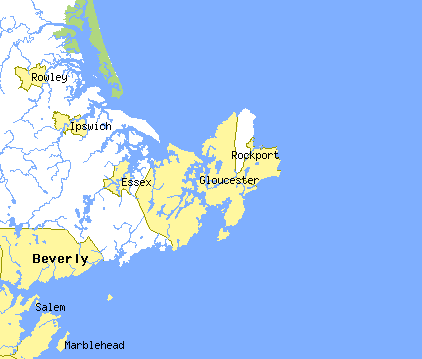A clear cold day, wind northwest.
 |
| Cape Ann |
Soon struck off to the shore in Beverly. See the discolor thistle on a sandy beach, and Phaseolus diversifolius (three-lobed bean vine), with pretty terete long pods, some ripe, but a few flowers still. Aster linifolius, perhaps still in prime, — though it has a flexuous stem, — in a marsh, and lyme-grass, apparently like ours, along edge of marsh.
Dined on the edge of a high rocky clifl', quite perpendicular, on the west side of entrance of Manchester Harbor.
One mile southeast of the village of Manchester, struck the beach of “musical sand,” just this side of a large, high, rocky point called Eagle Head. This is a curving sandy beach, maybe a third of a mile long by some twelVe rods wide. (We also found it on a similar but shorter beach on the east side of Eagle Head.)
We first perceived the sound when we scratched with our umbrella or finger swiftly and forcibly through the sand; also still louder when we struck forcibly with our heels “scuffing” along. The wet or damp sand yielded no peculiar sound, nor did that which lay loose and deep next the bank, but only the more compact and dry.
The sound was not at all musical, nor was it loud. Fishermen might walk over it all their lives, as indeed they have done, without noticing it. R., who had not heard it, was about right when he said it was like that made by rubbing on wet glass with your fingers. I thought it as much like the sound made in waxing a table as anything. It was a squeaking sound, as of one particle rubbing on another. I should say it was merely the result of the friction of peculiarly formed and constituted particles.
The surf was high and made a great noise, yet I could hear the sound made by my companion’s heels two or three rods distant, and if it had been still, probably could have heard it five or six rods.
We kept thence along the rocky shore to Kettle Cove, where, however, I did not find any rocks like Lewis’s.
Somewhere thereabouts Scirpus maritimus, with its great spikes now withered. In the marsh at Kettle Cove, Gerardia maritima, apparently in prime, four or five inches high; Euphorbia polygonifolia, six inches in diameter. Spartina glabra in the salt water of the cove.
The shore, thus far, from Beverly Bridge had been a succession of bold rocky points half a mile apart, with sometimes curving sandy beaches between, or else rocks.
We now kept the road to Gloucester, leaving the shore a mile or more to the right, wishing to see the magnolia swamp. This was perhaps about a mile and a half beyond Kettle Cove. After passing over a sort of height of land in the woods, we took a path to the left, which within a few rods became a corduroy road in the swamp. Within three or four rods on the west side of this, and perhaps ten or fifteen from the highroad, was the magnolia.
It was two to seven or eight feet high, but distinguished by its large and still fresh green leaves, which had not begun to fall. I saw last year's shoots which had died down several feet, and probably this will be the fate of most which has grown this year.
The swamp was an ordinary one, not so wet but we got about very well. The bushes of this swamp were not generally more than six feet high. There was another locality the other side of the road.
Cooked our supper in a salt marsh some two miles this side of Gloucester, in view of the town. We had cooked our tea for dinner with dead bayberry bushes; now we used the chips and bark which the tide had deposited in little parcels on the marsh, having carried water in our dippers from a brook, a quarter of a mile.
There was a large patch of samphire turned a bright crimson, very conspicuous, near by on the flat marsh, the more conspicuous because large and in the midst of the liquid green of the marsh.
We sat on some stones which we obtained flat in the marsh till starlight.
I had seen in this day’s walk an abundance of Aster cordifolius (but no A. undulatus); also saw A. corymbosus, which is a handsome white wood aster; and, very common, what I called A. longifolius, with shorter thick, clasping leaves and growing in drier ground than ours, methinks; also, all along the road, the up-country hard, small, mulberry-shaped high blackberry, and many still holding on. This may be due to the cool air of the Cape. They were quite sweet and good. Vide a specimen.
The foliage had but just fairly begun to change. Put up in Gloucester.
H. D. Thoreau, Journal, September 22, 1858
 |
| September 22, 2018 |




No comments:
Post a Comment